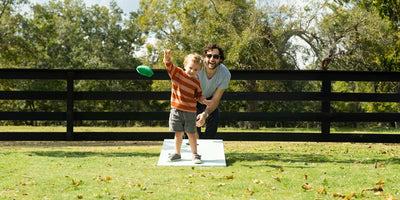The Top 5 Life-Saving Swimming Skills You Need to Know
According to the American Red Cross, being able to swim isn't enough - you need to learn water safety and specific skills that can save your life. Learning these skills could mean the difference between survival and tragedy. It's time to equip yourself with the knowledge that could save your life in the water.
What Are the Basics of Water Safety?

When it comes to enjoying the water - whether it's a pool, lake, or ocean - understanding the basics of life-saving swimming skills is paramount for a fun and secure experience.
Stay aware of your surroundings and any potential hazards. Familiarize yourself with the water’s depth and the safety equipment’s location. Be mindful of currents or waves in open water settings. Swim in designated areas with lifeguards when possible.
Most importantly, master those basic swimming skills. Enrolling in swimming lessons, especially for beginners, is advisable to gain confidence and competence in the water. Additionally, understanding the importance of never swimming alone and keeping a watchful eye on others, especially children, contributes to a collective commitment to water safety.
How Do You Stay Safe Around Water?
In aquatic recreation, understanding and implementing water safety measures are essential for an enjoyable and risk-free experience. So, let's dive into the life-saving swimming skills that collectively create a culture of responsible water enjoyment.
1. Step or Jump Into Water Over Your Head And Return to the Surface

Mastering stepping or jumping into water over your head at a swimming pool, lake, or beach is not just about making a splash – it's a vital safety tool that can save lives in aquatic environments. Begin by calmly stepping into the water, feeling the gradual increase in depth, and ensuring you maintain control over your movements. Taking a moment to acclimate to the water's depth allows you to gauge its buoyancy and make necessary adjustments.
Once submerged, resist the urge to panic and focus on controlled arm and leg movements to propel yourself upward. Use a combination of arm strokes and leg kicks to ascend gradually, exhaling as you rise. This deliberate approach conserves energy and ensures a smooth return to the surface.
Maintain awareness of your surroundings, scan for potential hazards like sharp stones on the beach or in-pool furniture by the pool, and always gauge the water's depth before moving.
2. Float or Tread Water for At Least One Minute

Being able to float or tread water for one minute is a life-saving swimming skill. In the event of accidental submersion or exhaustion, this ability allows you to stay afloat while assessing the situation and planning your next move.
To master this skill, controlling your breathing and maintaining a relaxed posture is crucial. To achieve a stable float, start by taking a deep breath, relaxing your body, and lying back with your face above the water. The key is distributing body weight evenly, allowing the body to float naturally on the water's surface.
Extend your arms to the sides and keep your legs straight, allowing your body to float naturally. Gentle sculling motions with your hands or a flutter kick with your legs can help maintain balance.
Treading water is another essential skill, especially in deeper water where floating might not be feasible. The eggbeater kick is a popular technique for treading water. To perform this kick, start by positioning your arms flexibly and keeping your body vertical in the water.
Move your legs in a circular motion, with one leg moving clockwise and the other counterclockwise. This action creates a consistent upward and downward movement, allowing you to stay afloat.
Regularly practicing these techniques enhances your water competency, providing you with the skills needed to stay safe in various aquatic situations.
3. Turn Around in a Full Circle and Find an Exit

Knowing your surroundings and quickly locating an exit point is crucial in any aquatic setting. Turn over and turn around the water in a full circle to get a 360-degree perspective of your environment as you identify the nearest exit and potential obstacles.
This skill is essential in open water scenarios, where currents and changing conditions can disorient even experienced swimmers. To master this, regularly practice swimming in different environments to familiarize yourself with varying conditions. In disorientation, resist panic and calmly turn in a complete circle to survey your environment. Trust your instincts and head towards the most identifiable landmark or the right direction.
To bolster situational awareness and preparedness for open water scenarios, individuals can engage in regular training exercises that simulate various conditions and practice turning around in a full circle to find an exit. Additionally, staying informed about local water conditions and currents and having the appropriate safety equipment can strengthen one's ability to navigate and respond effectively to unexpected situations.
4. Swim At Least 25 Yards to an Exit Without Stopping

First, ensure you have a strong and comfortable swimming technique. This involves proper arm strokes, controlled breathing, and efficient kicking to maintain a steady pace.
Break down the distance into manageable segments, employing a combination of freestyle and proper flip turns to maintain momentum. Regular practice and ongoing education can significantly enhance your swimming safety, allowing you to handle any water-related emergency.
5. Exit from the Water. If in a Pool, be Able to Exit Without Using a Ladder

Learning to exit the water without relying on a ladder in a pool can be a game-changer in unexpected scenarios. In emergencies, ladders may not always be accessible, and knowing how to exit independently is crucial for personal safety. When approaching the pool edge, look for a shallow area where you can stand, allowing you to maintain control as you exit.
Once you've located a suitable spot, turn your body toward the edge, extend your arms, and use a steady, controlled motion to pull yourself up and out of the water. This technique ensures a safer exit and is especially important when a ladder is not readily available or feasible.
Staying safe around water is not just a matter of acquiring these top five swimming skills but a holistic approach combining awareness, preparedness, and responsible decision-making.
Essential Swimming Skills for a Safer Experience

These skills are not just for emergencies but integral to fostering a culture of water safety and enjoyment. At Ledge, we believe in the importance of staying safe around water. That’s why we started Ledge Loves. With every swim lesson donation, lives are saved. If you also believe in safe swimming, feel free to join in on our mission with a donation.
Donate to Ledge Loves




















